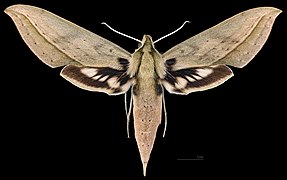Xylophanes anubus
| Xylophanes anubus | |
|---|---|

| |
| Upperside | |

| |
| Underside | |
| Scientific classification | |
| Domain: | Eukaryota |
| Kingdom: | Animalia |
| Phylum: | Arthropoda |
| Class: | Insecta |
| Order: | Lepidoptera |
| Family: | Sphingidae |
| Genus: | Xylophanes |
| Species: | X. anubus
|
| Binomial name | |
| Xylophanes anubus | |
| Synonyms | |
| |
Xylophanes anubus is a moth of the family Sphingidae first described by Pieter Cramer in 1777.
Distribution
[edit]It is found in Suriname, Mexico, Belize, Nicaragua, Costa Rica and south to Brazil, Bolivia and Argentina.
Description
[edit]The wingspan is 97–102 mm. Females are larger than males. It is a very variable species in terms of size and degree of development of the oblique lines of the forewing upperside. The costal margin of the forewing is often rather strongly convex and the apex is recurved. The abdomen has three dorsal lines, the median line is usually the most distinct but may be absent and the lateral lines are sometimes reduced to rows of dots. The forewing upperside is either with or without a dark cloud distal to discal cell. There are seven oblique lines present of which the third is the heaviest.
-
Female dorsal
-
female ventral
Biology
[edit]Adults are on wing year round in Costa Rica.
The larvae feed on Psychotria panamensis, Psychotria chiapensis, Psychotria psychotriifolia, Psychotria nervosa and Garrobo species.
References
[edit]- ^ "CATE Creating a Taxonomic eScience - Sphingidae". Cate-sphingidae.org. Archived from the original on 2012-12-20. Retrieved 2011-10-25.
 This article incorporates text from this source, which is in the public domain.
This article incorporates text from this source, which is in the public domain.
External links
[edit]- Xylophanes anubus anubus at Silkmoths. Archived from the original May 13, 2006.


